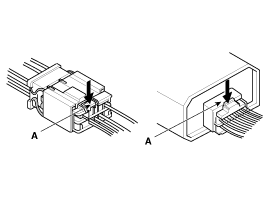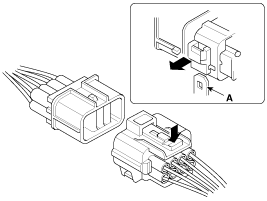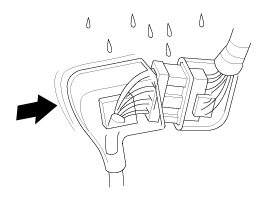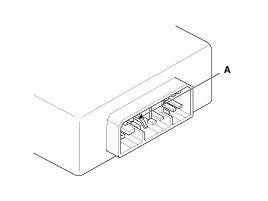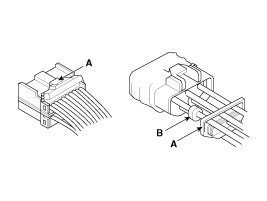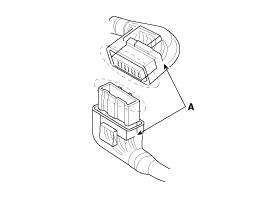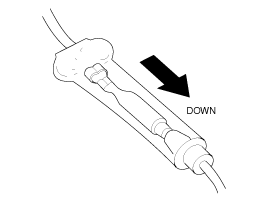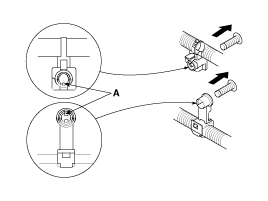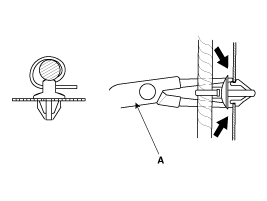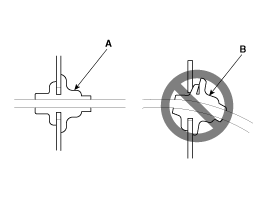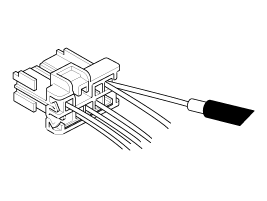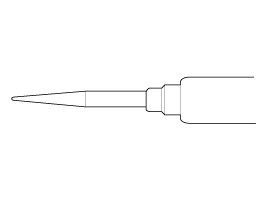 Kia Rio: General Troubleshooting Information
Kia Rio: General Troubleshooting Information
Before Troubleshooting
| 1. |
Check applicable fuses in the appropriate fuse/relay box.
|
| 2. |
Check the battery for damage, state of charge, and clean and tight
connections.
(Refer to the EE group - "Battery")
|
| 3. |
Check the alternator belt tension.
|
Handling Connectors
| 1. |
Make sure the connectors are clean and have no loose wire terminals.
|
| 2. |
Make sure multiple cavity connectors are packed with grease (except
watertight connectors).
|
| 3. |
All connectors have push-down release type locks (A).
|
| 4. |
Some connectors have a clip on their side used to attach them
to a mount bracket on the body or on another component. This clip has
a pull type lock.
|
| 5. |
Some mounted connectors cannot be disconnected unless you first
release the lock and remove the connector from its mount bracket (A).
|
| 6. |
Never try to disconnect connectors by pulling on their wires;
pull on the connector halves instead.
|
| 7. |
Always reinstall plastic covers.
|
| 8. |
Before connecting connectors, make sure the terminals (A) are
in place and not bent.
|
| 9. |
Check for loose retainer (A) and rubber seals (B).
|
| 10. |
The backs of some connectors are packed with grease. Add grease
if necessary. If the grease (A) is contaminated, replace it.
|
| 11. |
Insert the connector all the way and make sure it is securely
locked.
|
| 12. |
Position wires so that the open end of the cover faces down.
|
Handling Wires And Harnesses
| 1. |
Secure wires and wire harnesses to the frame with their respective
wire ties at the designated locations.
|
| 2. |
Remove clips carefully; don't damage their locks (A).
|
| 3. |
Slip pliers (A) under the clip base and through the hole at an
angle, and then squeeze the expansion tabs to release the clip.
|
| 4. |
After installing harness clips, make sure the harness doesn't
interfere with any moving parts.
|
| 5. |
Keep wire harnesses away from exhaust pipes and other hot parts,
from sharp edges of brackets and holes, and from exposed screws and
bolts.
|
| 6. |
Seat grommets in their grooves properly (A). Do not leave grommets
distorted (B).
|
Testing And Repairs
| 1. |
Do not use wires or harnesses with broken insulation.
Replace them or repair them by wrapping the break with electrical
tape.
|
| 2. |
After installing parts, make sure that no wires are pinched under
them.
|
| 3. |
When using electrical test equipment, follow the manufacturer's
instructions and those described in this manual.
|
| 4. |
If possible, insert the remover tool from the wire side (except
waterproof connector).
|
| 5. |
Use a remover tool with a tapered tip.
Refer to the user's guide in the wiring repair kit II (Pub. No.
: 0K000 003 A05)
|
Five-step Troubleshooting
| 1. |
Verify the complaint
Turn on all the components in the problem circuit to verify the
customer complaint. Note the symptoms. Do not begin disassembly or testing
until you have narrowed down the problem area.
|
| 2. |
Analyze the schematic
Look up the schematic for the problem circuit.
Determine how the circuit is supposed to work by tracing the current
paths from the power feed through the circuit components to ground.
If several circuits fail at the same time, the fuse or ground is a likely
cause.
Based on the symptoms and your understanding of the circuit operation,
identify one or more possible causes of the problem.
|
| 3. |
Isolate the problem by testing the circuit.
Make circuit tests to check the diagnosis you made in step 2.
Keep in mind that a logical, simple procedure is the key to efficient
troubleshooting.
Test for the most likely cause of failure first. Try to make tests
at points that are easily accessible.
|
| 4. |
Fix the problem
Once the specific problem is identified, make the repair. Be sure
to use proper tools and safe procedures.
|
| 5. |
Make sure the circuit works
Turn on all components in the repaired circuit in all modes to
make sure you've fixed the entire problem. If the problem was a blown
fuse, be sure to test all of the circuits on the fuse. Make sure no
new problems turn up and the original problem does not recur.
|
Battery Reset
| Description |
When reconnecting the battery cable after disconnecting, recharging battery
after discharged or installing the memory fuse located on the driver's side
panel after removing, be sure to reset systems mentioned in the below table.
In addition, when replacing or reinstalling their fuses after removing,
they should be reset according to the below table. Please refer to the below
table when servicing.
| System |
Resetting |
||||||
| Auto up/down window |
Whenever the battery is disconnected, discharged or the related
fuse is replaced or reinstalled, reset the Auto up/down window system according
to the procedure below. 1) Turn the ignition switch to the ON position. 2) Pull up the power window switch in order that the window can close completely, and then keep pulling up the power switch for about 1 second. |
||||||
| Sunroof |
Whenever the battery is disconnected, discharged or the related
fuse is replaced or reinstalled, the sunroof system must be reset according
to the procedure below. 1) Turn the ignition switch to the ON position. 2) According to the position of the sunroof, do the following. - In case the sunroof is closed completely or tilted: Push the sunroof control lever upward until the sunroof tilts completely upward. - In case the sunroof is open: Push the sunroof control lever forward until the sunroof closes completely. Push the sunroof control lever upward until the sunroof tilts completely upward. 3) Release the sunroof control lever. 4) Push the sunroof control lever upward until the sunroof has returned to the original tilt position after it is raised a little higher than the maximum tilt position. Then, release the lever. 5) Push the sunroof control lever upward until the sunroof operates as follows; TILT DOWN → SLIDE OPEN → SLIDE CLOSE Then, release the lever. |
||||||
| Trip computer |
When the battery is disconnected and reconnected, the set functions
of the trip computer become initialized. So, you need to explain this information
to the customer. |
||||||
| Clock |
Whenever the battery terminals or related fuses are disconnected,
you must reset the time. When the ignition switch is in the ACC or ON position, the clock buttons operate as follows:
|
||||||
| Audio |
When the battery is disconnected and reconnected, the customer's
radio stations become initialized. So, you need to record the customer's
radio stations prior to service, and after service, set the customer's radio
stations into the audio. |
 Special Service Tools
Special Service Tools
Tool (Number and Name)
Illustration
Application
RKE Battery Checker
(09954-2P100)
Measuring the RKE battery
voltage
...
See also:
Exhaust Manifold: Components
1. Heat protector
2. Exhaust manifold
3. Exhaust manifold gasket
4. Exhaust manifold stay
...
Adjustment
Clutch Release Cylinder Air Bleeding
Procedure
Use the specified fluid. Avoid mixing different brands of flu ...
Specification
[AMS type (NON-OAD)]
Item
Specification
Rated voltage
13.5V, 90A
Speed in use
1,000 ~ 18,000 rpm
Voltage regulator
IC ...
Copyright ® www.kirmanual.com 2014-2025


